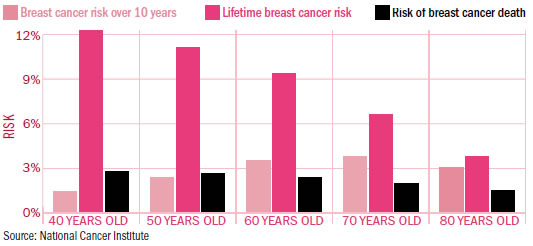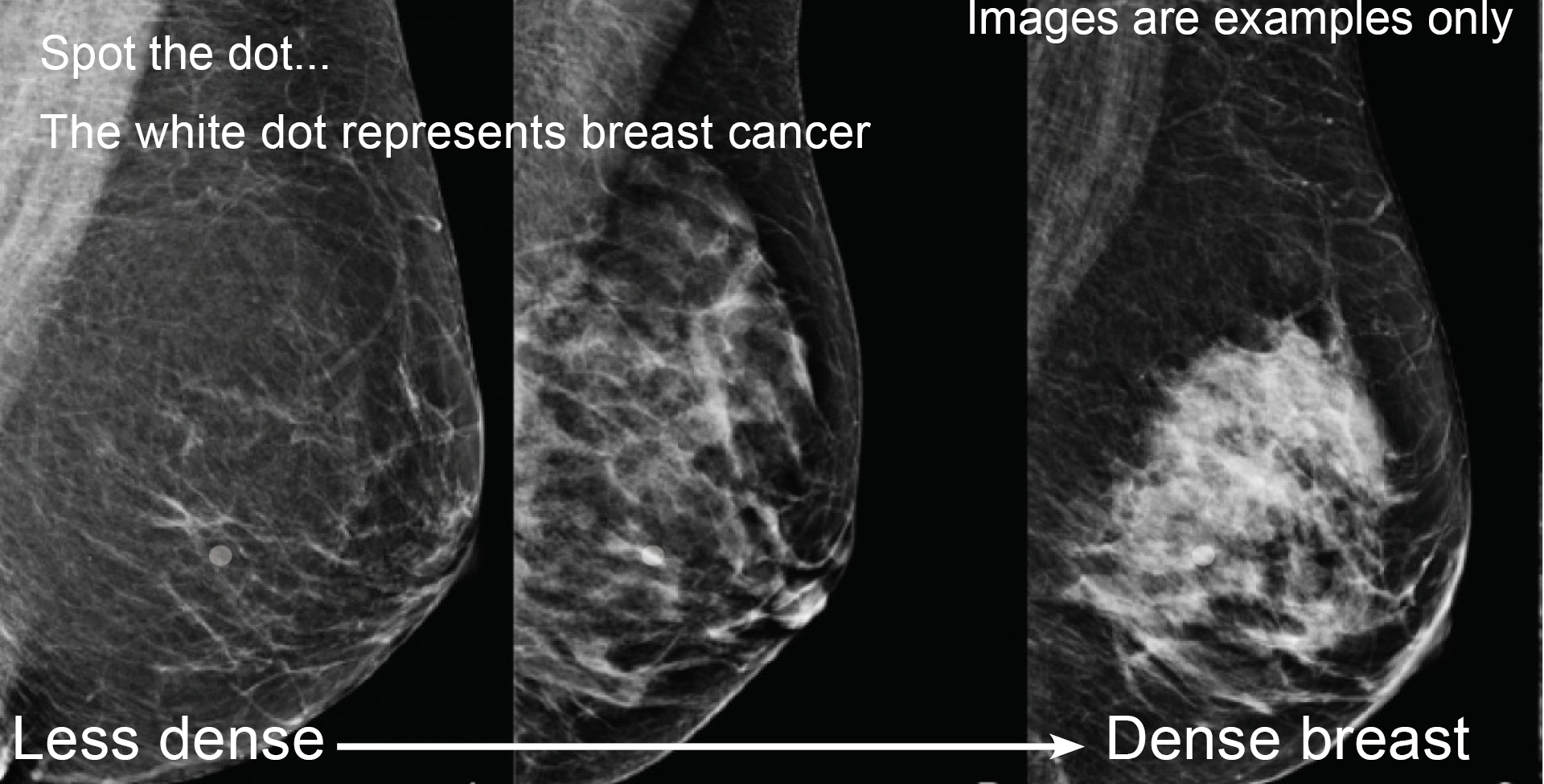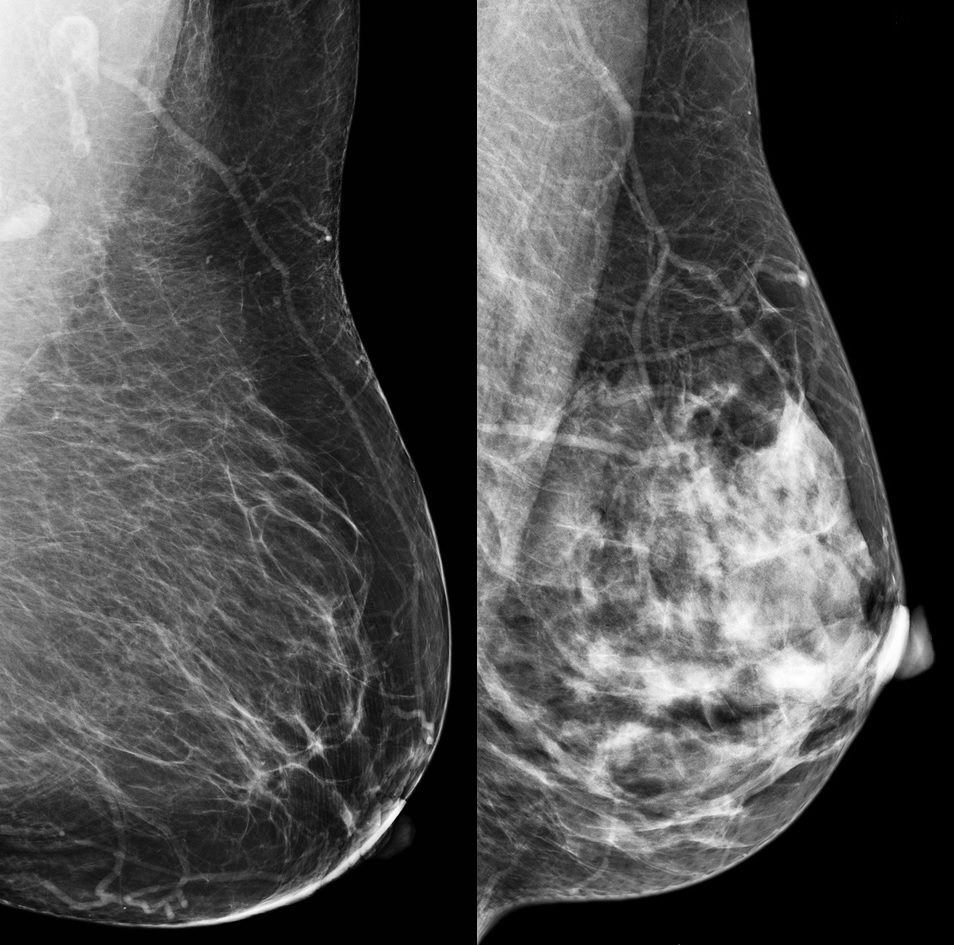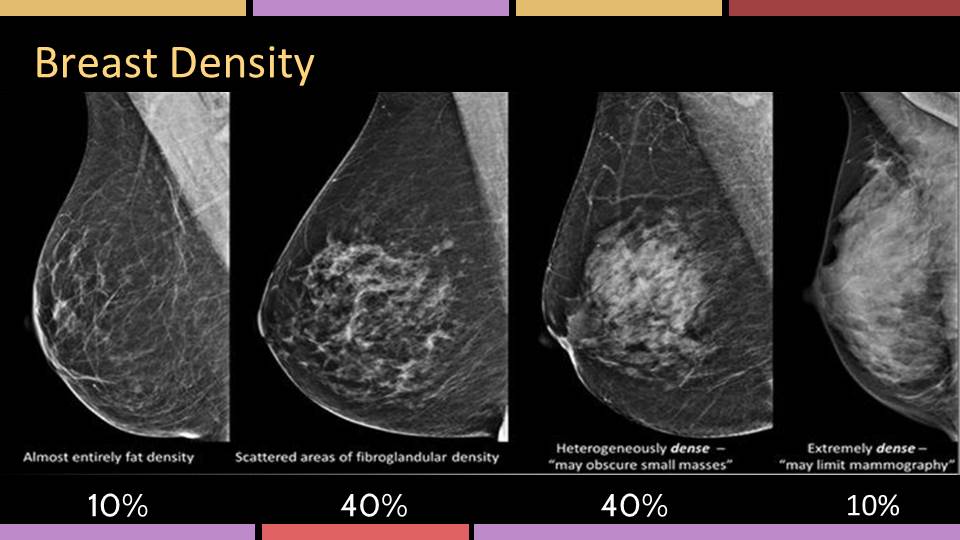For example according to the American Cancer Society about 1 out of 8 invasive breast cancers develop in women younger than 45. In females aged 50-74 in the UK breast cancer is the most common cancer accounting for around a third 34 of all cases in 2015-2017 1-4.

Good News About Early Stage Breast Cancer For Older Women Harvard Health
Screening mammograms are often less reliable for women under 40 years of age.

What ages can you get breast cancer. Everyone alive is growing older. Here are some statistics about breast cancer in women under 40. Other potential risk factors include genetics lack of childbearing or.
In my 23 yrs of practice my youngest patient was 19 and oldest 92 but I have colleagues who have seen it even younger than that. Signs and Symptoms of Breast Cancer. This spectrum of presentation can make the diagnosis difficult.
When these breast cancer cells spread to other parts of your body it is called metastasis. Its also uncommon in women in their 20s and 30s. Diagnosing breast cancer in women under 40 years old is more difficult because their breast tissue is generally denser than in older women.
About 800 women younger than 40 are. About 1 in 8 women are diagnosed with breast cancer during their lifetime. The density of breast tissue in younger women often makes it difficult to detect cancers on mammograms.
Plastic Surgery 21 years experience Depends. And as with many other diseases your risk of breast cancer goes up as you get older. The condition is most common in women over age 50 who have been through the menopause.
If you started your period before age 12 or started menopause after age 55 you are more likely to get breast cancer. Women who have never been pregnant have a higher risk as well. In other words if only ONE 17-year-old in the history of mankind developed breast cancer this would validate saying Yes a 17-year-old can get breast cancer The publicity of these exceedingly rare events makes it seem that its more common than it actually is in young people.
Breast cancer is the most common type of cancer in the UK. In females aged 25-49 in the UK breast cancer is the most common cancer accounting for more than 4 in 10 44 of all cases in 2015-2017. However around 11 of all new breast cancer cases in the United States were of women aged younger than 45 years.
The median is the middle value of a group of numbers so about half of men with breast cancer are diagnosed before age 68 and about half are diagnosed after age 68. The primary risk factors for breast cancer are being female and older age. The vast majority of breast cancers are diagnosed in women over the age of 50.
According to the National Cancer Institute NCI doctors most often diagnose breast cancer in females aged 5564 years. Fixed risk factors things that cannot be changed such as age and biological sex. The median age of diagnosis varies by race and ethnicity.
Breast cancer can be diagnosed with a not palpable not able to be felt abnormality seen on mammogram to a large palpable able to be felt by a patient or physician to an obvious mass growing through the skin. The chances increase slightly as girls move through their teenage years but its still very rare with an. It can occur in the very young as well as in the mature and elderly.
Typically the risk increases with age and screening for breast cancer for women of average risk begins at age 40. Just been diagnosed with breast cancer age 29. BreastScreen Australia targets women aged 50 to 74 as 75 of all breast cancers occur in women over the age of 50.
About 2 out of 3 invasive breast cancers are found in women 55 or older. Answered on Aug 10 2013. Most women diagnosed with breast cancer are over the age of 50 but younger women can also get breast cancer.
Based on data from 20122016 the median age of diagnosis in females. Just been diagnosed with breast cancer age 29. About 12000 women younger than 40 are expected to be diagnosed with breast cancer each year.
The median age of diagnosis of breast cancer overall for men in the US. Developing breast cancer when youre a teenager is extremely rare. All women who are 50 to 70 years of age should be screened for breast cancer every 3 years as part of the NHS Breast Screening Programme.
About 8 out of 10 cases of breast cancer happen in women over 50. The risk of developing breast cancer increases with age. Risk factors can be divided into two categories.
It should be noted that these risk factors are not direct causes of breast cancer. Modifiable risk factors things that people can change themselves such as consumption of alcoholic beverages and. Its almost unheard of for girls ages 14 and younger to develop breast cancer.
By the time a lump in a younger womans breast can be. According to the Centre of Disease Control and Prevention women aged 50 years or more are most likely to suffer from breast cancer.
When the breast is dense its harder to see the little cancers. Dense breast tissue refers to the appearance of breast tissue on a mammogram.
Radiologists can investigate tissue through multiple levels of images to see if an area of concern is regular tissue or a possible tumor.

Dense breast tissue mammogram. Doctors will use four categories to rank breast tissue density. Breast cancer patients who have dense breasts are not more likely to die from breast cancer than patients with non-dense fatty breasts. For about half of women screening mammograms reveal they have breast tissue that is categorized as dense.
A cancer masked on a 2D mammogram could still be masked on tomosynthesis unless the cancer is at least partially surrounded by fatty tissue. How do I know if I have dense breasts. Women with dense breasts get the greatest benefit from 3D mammography.
Your provider or radiologist will be able to tell you if your breasts are dense and if the Invenia ABUS 20 screening can be used. Some breast tumors are hidden masked by overlying or surrounding dense breast tissue Fig. Meanwhile some women have dense breast tissue.
Only a mammogram can show if a woman has dense breasts. The term breast density refers to the relative amount of radiopaque epithelial and stromal tissue elements compared with the amount of radiolucent fatty elements seen at mammography Fig 1. Compression flattens the breast to capture an image of it.
The breast anatomy includes lobules ducts fatty and fibrous connective tissue. Breast density is a term that describes the relative amount of these different types of breast tissue as seen on a mammogram. Dense breast tissue can only be seen on a mammogram.
Some breasts are mostly fat fatty breasts and some breasts are mostly breast and connective tissue dense breasts. Dense breasts have relatively high amounts of glandular tissue and fibrous connective tissue and relatively low amounts of fatty breast tissue. Dense breast tissue is common and is not abnormal.
When a breast is easy to see through its easier to detect cancers. How Can Invenia ABUS Help. By creating multiple layers of imaging 3D mammograms can reveal problem areas in dense tissue Dr.
Because its hard to tell the difference between a tumor and dense breast tissue on a mammogram a small. A normal mammogram result is given when cancer is present. A breast with more fibroglandular tissue than fat is considered dense.
As breast density increases the ability of mammograms to show cancers generally decreases which means in some cases. Breast tissue is composed of milk glands milk ducts and supportive tissue dense breast tissue and fatty tissue nondense breast tissue. Essentially mammograms turn a 3D object into a 2D object.
By looking at your mammogram or the measure of breast density your health care provider may conclude you have dense breasts. However dense breast tissue can make it harder to evaluate the results of your mammogram and may also be associated with an increased risk of breast cancer. Dense tissue can hide cancers.
Mammography uses X-rays to detect different densities in the breast including densities that may be tumors. Skin also appears radiopaque at mammography and accounts for some portion of tissue density. So does a possible tumor.
The mammogram images below show a range of breast density. Ourbreast tissue contains different mixtures or varieties in the amount of fatty and fibroglandular substance. A normal mammogram usually looks mostly gray with a little white showing dense breast tissue thats healthy.
Fibrous and glandular tissue looks white on a mammogram. All mammograms use x-ray technology and dense tissue absorbs more x-rays than fatty tissue. Dense breast tissue is normal seen in 40-50 percent of women and is a risk factor for breast cancer.
The language used in the report may be mandated by law and say something like Your mammogram shows that your breast tissue is dense. A woman is called. While fatty tissue appears dark on a mammogram dense tissue appears white.
How does dense breast tissue look on a mammogram. However dense breast tissue can make it harder to evaluate the results of your mammogram and may also be associated with an increased risk of breast cancer. Breast tissue may either be called non-dense more fatty or dense less fatty with more fibroglandular tissue.
Dense breast tissue is common and is not abnormal. Dense tissue like glands appears white in the image. When a woman is young under 50 or premenopausal the breasts are more dense according to the mammogram.
Its a normal and common finding. This can make it tougher to see tumors since dense tissue also looks white. 1 Knowing whether you have dense breasts is important because.
This is because dense breast tissue and breast cancer both appear white on a mammogram - as a result the cancer can be masked by dense tissue. When you get older the breasts become mostly fat and are easy to see through. Your mammogram shows that your breast tissue is dense.
A mammogram is an X-ray of the breast that allows a doctor to identify potentially cancerous lesions in any dense breast tissue. For screening mammograms the breast is compressed in two ways from top to bottom and from side to side.
Skin also appears radiopaque at mammography and accounts for some portion of tissue density. Breast density is a term that describes the relative amount of these different types of breast tissue as seen on a mammogram.
Dense Breast Clinic Cooper University Health Care
Mammogram Difficult Case 26 Heterogeneously dense breast Cancer can be difficult to detect with this type of breast tissue The fibroglandular tissue white areas may hide the tumor The breasts of younger women contain more glands and ligaments resulting in dense breast tissue.

Density breast tissue mammogram. Dense breast tissue refers to the appearance of breast tissue on a mammogram. To determine the level of breast density the radiologist who analyzes your mammogram will use the Breast Imaging Reporting and Data System BI-RADS to calculate the amount of dense tissue in your breast. This makes it harder for the radiologist to pinpoint abnormalities in breast tissue because tumors and masses also present as white on the test.
Breast Density Level C and D are considered as Dense Breasts Strong influence. Dense breast tissue can also make it harder to see signs of cancer in mammograms. Scattered areas of fibroglandular density.
A normal mammogram usually looks mostly gray with a little white showing dense breast tissue thats healthy. Also detection of breast cancer using mammography is more difficult in women with dense breast tissue. Your mammogram shows that your breast tissue is dense.
Breast density is a measure used to describe mammogram images. Breast density describes the amount of glandular tissue in the breast meaning dense breasts have less fatty tissue than normal breasts. Breast density is classified on a mammogram report in one of four ways.
Breasts are made up of breast tissue the milk ducts and lobules which may be called glandular tissue and fat. Breast tissue is composed of milk glands milk ducts and supportive tissue dense breast tissue and fatty tissue nondense breast tissue. In fact dense tissue can hide cancers in mammograms.
For about half of women screening mammograms reveal they have breast tissue that is categorized as dense. On a mammography report breast density is assigned to one of the following four categories The breasts are almost entirely fatty about 10 of women. But with the latest advancements in technology 3D mammography offers more precise and accurate imaging giving women who have dense breast tissue or implants extra peace of mind.
While fatty tissue appears dark on a mammogram dense tissue appears white. How do I know if I have dense breasts. Dense breast tissue more ligaments and glands than fat can make mammogram imaging challenging.
Breast density reflects the amount of fibrous and glandular tissue in a womans breasts compared with the amount of fatty tissue in the breasts as seen on a mammogram. 1 Knowing whether you have dense breasts is important because. Dense breast tissue may increase a womans chance of developing breast cancer.
Dense breast tissue is important for a number of reasons. Its not a measure of how the breasts feel. Dense breast tissue is common and is not abnormal.
Dense tissue like glands appears white in the image. Dense breasts have relatively high amounts of glandular tissue and fibrous connective tissue and relatively low amounts of fatty breast tissue. Its a normal and common finding.
Here is the classification system used by radiologists interpreting your mammogram. The term breast density refers to the relative amount of radiopaque epithelial and stromal tissue elements compared with the amount of radiolucent fatty elements seen at mammography Fig 1. This is a relatively common condition.
Women with Dense Breasts 6 times more likely to develop Breast Cancer than women with Fatty Breasts. Although dense breast tissue which appears white on mammograms can mask the presence of tumors a new study suggests that having dense breasts alone may not be a reason for additional screening. This can make it tougher to see tumors since dense tissue also looks white.
High Density of Breast Tissue listed as a Strong Influence for Breast Cancer ahead of Family History. One important factor is that dense breast tissue shows up white on a mammogram. Meanwhile some women have dense breast tissue.
High breast density as seen on a mammogram is linked to an increased risk of breast cancer. Only a mammogram can show if a woman has dense breasts. Knowing about breast density is important because women who have dense breast tissue have a higher risk of breast cancer compared to women with less dense breast tissue.
Dense breast tissue can only be seen on a mammogram. When viewed on a mammogram women with dense breasts have more dense tissue than fatty tissue. When you receive your report after your screening mammogram you may learn that you have dense breast tissue.
Dense breast tissue is seen only on a mammogram and appears as a white solid area that is hard to see through. Why Are Dense Breasts Concerning. Conversely fatty breast tissue appears black on a mammogram making it much easier to notice abnormalities.
Most importantly women with higher-density breasts have a higher risk for breast cancer. Connective tissue helps hold everything place. However dense breast tissue can make it harder to evaluate the results of your mammogram and may also be associated with an increased risk of breast cancer.
The calcium readily absorbs the X-rays from mammograms. Breasts are almost all fatty tissue.

Dense Breast Tissue And Breast Cancer Risk
Calcifications are small deposits of calcium that show up on mammograms as bright white specks or dots on the soft tissue background of the breasts.
Heterogeneous breast tissue. More of the breast is made of dense glandular and fibrous tissue described as heterogeneously dense. This can make it hard to see small tumors in or around the dense tissue. Calcifications typically dont show up on ultrasounds and.
A special focus is on microwave breast cancer imaging in heterogeneous dense breast tissue using a multistatic radar with 31 transmitters and receivers. Heterogeneously dense meaning there are some areas of non-dense tissue still most of the breast tissue is dense. Normal breast tissue is rather heterogeneous as are the breast cancer types mainly originating from the ducts 2.
Extremely dense meaning the breast tissue is nearly all dense. Heterogeneity in the breast is a common finding typically leading to class ii or birads 2 result on the ma. It occurs in 40 of women and while normal can make it more difficult to detect breast cancer on mammography.
Cell cannibalism is a unique pathological phenomenon that has been observed in various types of human tumors including breast cancer 1. 10021 Breast Tissue Density. For example a dermoid cyst has heterogeneous attenuation on CT.
The breasts are heterogeneously dense which may obscure small masses. The breast tissue density among women is quite variable and ranges from dense to lucent and any degree of mixed formsthat is what heterogeneous means. There are a few phantoms based on heterogeneous and dispersive breast tissue dielectric properties presented in the literature4 5 67.
For mammography the normalized glandular dose based on the homogeneous tissue approximation was on average 27 higher than that estimated using the true heterogeneous glandular tissue distribution Wilcoxon Signed Rank Test p 000046. The bulk of the breast is comprised of fat lobules and uniformly echogenic bands of connective tissue homogeneous background echotexture fibroglandular deep to a thin hypoechoic layer of subcutaneous fat there is a thick zone of homogeneously echogenic fibroglandular tissue. The right breast is surgically absent.
Heterogeneous refers to a structure with dissimilar components or elements appearing irregular or variegated. The patient below has heterogeneously dense breast tissue which means that more than half of the tissue in her breast is dense. The finding is only seen on lateromedial LM conventional mammogaphy and digital breast.
The ability of a mammogram to find cancer in this breast is compromised and the patient should be sent for a breast ultrasound or MRI in addition to an annual mammogram. This is usually found in about 40 of women. Still most of the breast tissue is non-dense.
The left breast demonstrates a 6-mm group of heterogeneous calcifications in the superior and posterior depth 7 cm from the nipple circle in Fig. It was found that conventional delay-and-sum imaging which assumes constant permittivity of the whole breast is not able to resolve the tumour even in the case of perfect calibration and assuming the best possible average permittivity of the breast tissue. C Heterogeneously dense breast tissue with many areas of glandular tissue and fibrous connective tissue found in about 40 of women D Extremely dense breast tissue found in about 10 of women If you are told that you have dense breasts it means that you have either heterogeneously dense C or extremely dense D breasts.
Specialists term the breast tissue in type 3 as heterogeneously dense. For dedicated breast CT the overestimation of normalized glandular dose was on average 8 49 kVp spectrum p 000045 and 4 80 kVp. This is found in about 10 of women.
Breast cancer tissues display profound heterogeneity which is important for clinical diagnosis and therapy. There are scattered areas of dense glandular and fibrous tissue. Heterogeneously dense breasts is a term used in mammography to describe breasts with a higher percentage of glandular and supportive tissue than fat.
The breasts have almost no fatty tissue. Heterogeneity in the breast is a common finding typically leading to class ii or birads 2 result on the ma. Imaging of the breast is imperfect at best.
Most of the breast is dense tissue with some areas of fat. It is the antonym for homogeneous meaning a structure with similar components. This is found in about 40 of women.
The parenchyma ranges from 51 to 75 of the breast tissue. Additionally the microenvironment plays a critical role in the cancer progression through both the chemical and cell-cell interactions 3 4. Heterogeneous means something contains many different items and has many different variations.
It is important to be able to match the dielectric properties.
